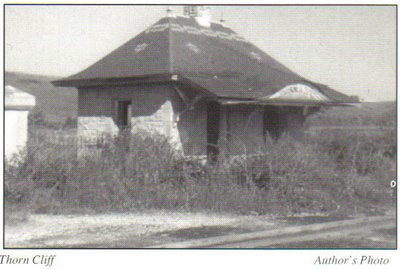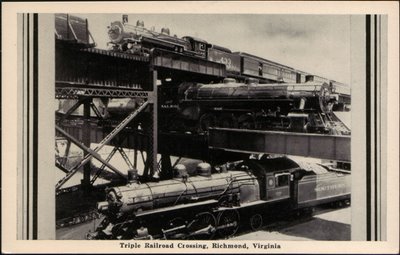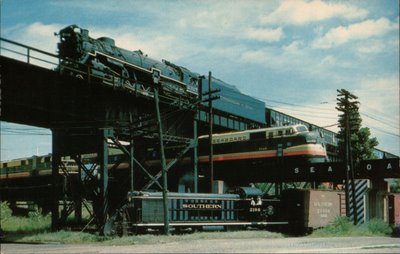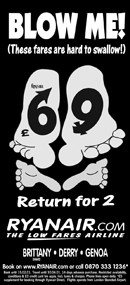Commuter Rail Craziness
From yesterday's Boston Globe...
This week, the the Massachusetts Bay Transportation Authority, which manages the Boston area mass transi t system commonly known as the "T", confronted the Massachusetts Bay Commuter Railroad over its poor management of the MBTA-affiliated commuter train system that serves East Massachusetts. The MBCR took over the management and operation of the MBTA's commuter rail system in 2003, with the understanding (under contract) that the MBCR would maintain a 90% or better on-time performance and adhere to strict limits on the numbers of out-of-service locomotive and coach equipment. At a time when commuter rail patronage is at an all-time high, due to excessive prices for gasoline and a recent catastrophe in the city's underground Central Artery (the "Big Dig"), in which a tunnel ceiling panel collapsed and crushed a motorist to death, the MBCR continues failing to meet the standards set by the MBTA.
t system commonly known as the "T", confronted the Massachusetts Bay Commuter Railroad over its poor management of the MBTA-affiliated commuter train system that serves East Massachusetts. The MBCR took over the management and operation of the MBTA's commuter rail system in 2003, with the understanding (under contract) that the MBCR would maintain a 90% or better on-time performance and adhere to strict limits on the numbers of out-of-service locomotive and coach equipment. At a time when commuter rail patronage is at an all-time high, due to excessive prices for gasoline and a recent catastrophe in the city's underground Central Artery (the "Big Dig"), in which a tunnel ceiling panel collapsed and crushed a motorist to death, the MBCR continues failing to meet the standards set by the MBTA.
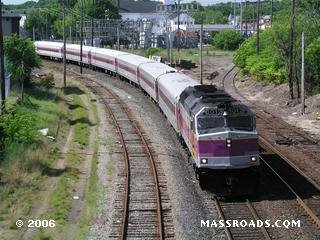
A meeting between the MBTA officials and the MBCR was scheduled yesterday, and the article notes the seriousness of the issue as the head of the MBCR was called from vacation to attend the meeting.
While at work, I often hear complaints from colleagues about their "horrible mornings" on the MBCR. Trains are late, some coaches have no air conditioning (which causes overcrowding in the cooler train cars), and some of the windows are so scuffed that one cannot even look through the glass panels. Improvements in these areas, which are being addressed through a $23.5 million grant given by the MBTA to the MBCR, have progressed at a snail's pace, much to the disappointment of the MBTA. However, the MBCR assures that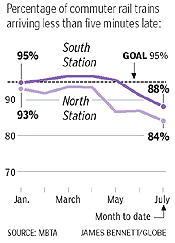 these improvements will be completed in the next 18 months.
these improvements will be completed in the next 18 months.
My experiences on the commuter rail have all been positive, but I have never ridden one of the trains during rush hour. I can only imagine how frustrating it would be fighting through a crowd in North Station to reach the correct train (I have also heard of the commuter crowds being so packed in there that people have missed their trains), only to find that their train has no remaining open seats, no A/C, and no operating restroom.
What's most interesting to me about this issue: The MBTA is constantly bombarded with rider complaints about its management of the subway system. The system is in serious debt and continues to make "improvements" that only add more headaches to the system (case in point: the Charlie Card). This incident strikes me as the MBTA's opportunity to point its finger at another company, deflecting blame from its own failures to offer efficient, user-friendly service.
This week, the the Massachusetts Bay Transportation Authority, which manages the Boston area mass transi
 t system commonly known as the "T", confronted the Massachusetts Bay Commuter Railroad over its poor management of the MBTA-affiliated commuter train system that serves East Massachusetts. The MBCR took over the management and operation of the MBTA's commuter rail system in 2003, with the understanding (under contract) that the MBCR would maintain a 90% or better on-time performance and adhere to strict limits on the numbers of out-of-service locomotive and coach equipment. At a time when commuter rail patronage is at an all-time high, due to excessive prices for gasoline and a recent catastrophe in the city's underground Central Artery (the "Big Dig"), in which a tunnel ceiling panel collapsed and crushed a motorist to death, the MBCR continues failing to meet the standards set by the MBTA.
t system commonly known as the "T", confronted the Massachusetts Bay Commuter Railroad over its poor management of the MBTA-affiliated commuter train system that serves East Massachusetts. The MBCR took over the management and operation of the MBTA's commuter rail system in 2003, with the understanding (under contract) that the MBCR would maintain a 90% or better on-time performance and adhere to strict limits on the numbers of out-of-service locomotive and coach equipment. At a time when commuter rail patronage is at an all-time high, due to excessive prices for gasoline and a recent catastrophe in the city's underground Central Artery (the "Big Dig"), in which a tunnel ceiling panel collapsed and crushed a motorist to death, the MBCR continues failing to meet the standards set by the MBTA.
A meeting between the MBTA officials and the MBCR was scheduled yesterday, and the article notes the seriousness of the issue as the head of the MBCR was called from vacation to attend the meeting.
While at work, I often hear complaints from colleagues about their "horrible mornings" on the MBCR. Trains are late, some coaches have no air conditioning (which causes overcrowding in the cooler train cars), and some of the windows are so scuffed that one cannot even look through the glass panels. Improvements in these areas, which are being addressed through a $23.5 million grant given by the MBTA to the MBCR, have progressed at a snail's pace, much to the disappointment of the MBTA. However, the MBCR assures that
 these improvements will be completed in the next 18 months.
these improvements will be completed in the next 18 months.My experiences on the commuter rail have all been positive, but I have never ridden one of the trains during rush hour. I can only imagine how frustrating it would be fighting through a crowd in North Station to reach the correct train (I have also heard of the commuter crowds being so packed in there that people have missed their trains), only to find that their train has no remaining open seats, no A/C, and no operating restroom.
What's most interesting to me about this issue: The MBTA is constantly bombarded with rider complaints about its management of the subway system. The system is in serious debt and continues to make "improvements" that only add more headaches to the system (case in point: the Charlie Card). This incident strikes me as the MBTA's opportunity to point its finger at another company, deflecting blame from its own failures to offer efficient, user-friendly service.
